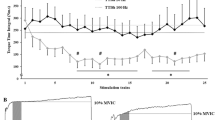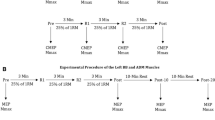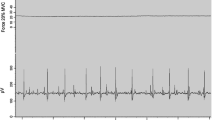Abstract
The aim of the present study was to determine whether central fatigue occurs when fatigue is electrically induced in the abductor pollicis brevis muscle. Three series of 17 trains (30 Hz, 450 μs, 4 s on/6 s off, at the maximal tolerated intensity) were used to fatigue the muscle. Neuromuscular tests consisting of electrically evoked and voluntary contractions were performed before and after every 17-train series. Both the force induced by the stimulation trains and maximal voluntary force generation capacity significantly decreased throughout the protocol (−27 and −20%, respectively, at the end of the protocol, P < 0.001). These decreases were accompanied by failure in muscle excitability (P < 0.01), as assessed by the muscle compound action potential (M-wave or Mmax), leading to significant impairment in the muscle contractile properties (P < 0.05), as assessed by the muscle mechanical response (Pt). Central fatigue indices (level of activation, RMS/Mmax and H reflex) were not significantly changed at any point in the protocol. This gives evidence of preserved motor command reaching the motor neurons and preserved spinal excitability. The results indicate that this low-frequency stimulation protocol entails purely peripheral fatigue development when applied to a low fatigue-resistant muscle.



Similar content being viewed by others
References
Allen DG, Westerblad H (2001) Role of phosphate and calcium stores in muscle fatigue. J Physiol 56(3):657–665
Allen GM, Gandevia SC, McKenzie DK (1995) Reliability of measurements of muscle strength and voluntary activation using twitch interpolation. Muscle Nerve 18:593–600
Allen DG, Lamb GD, Westerblad H (2008) Skeletal muscle fatigue: cellular mechanisms. Physiol Rev 88:287–332
Badier M, Guillot C, Danger C, Tagliarini F, Jammes Y (1999) M-wave changes after high- and low-frequency electrically induced fatigue in different muscles. Muscle Nerve 22:488–496
Barandun M, von Tscharner V, Meuli-Simmen C, Bowen V, Valderrabano V (2009) Frequency and conduction velocity analysis of the abductor pollicis brevis muscle during early fatigue. J Electr Kinesiol 19:65–74
Bary BK, Enoka RM (2008) The neurobiology of muscle fatigue: 15 years later. Integr Comp Biol 47(4):465–473
Bigland-Ritchie B, Furbush F, Woods JJ (1986) Fatigue of intermittent submaximal voluntary contractions: central and peripheral factors. J Appl Physiol 61(2):421–429
Binder-macleod SA, Snyder-Mackler L (1993) Muscle fatigue: clinical implications for fatigue assessment and neuromuscular electrical stimulation. Phys Ther 73:902–910
Boerio D, Jubeau M, Zory R, Maffiuletti NA (2005) Central and peripheral fatigue after electrostimulation-induced resistance exercise. Med Sci Sports Exerc 37(6):973–978
Dahlstedt AJ, Katz A, Westerblad H (2001) Role of myoplasmic phosphate in contractile function of skeletal muscle: studies on creatine kinase-deficient mice. J Physiol 533:379–388
Darques JL, Bendahan D, Roussel M, Giannesini B, Tagliarini F, Le Fur Y et al (2003) Combined in situ analysis of metabolic and myoelectrical changes associated with electrically induced fatigue. J Appl Physiol 95:1476–1484
Duchateau J (2009) Stimulation conditions can improve the validity of the interpolated twitch technique. J Appl Physiol 107(1):361
Duchateau J, Hainaut K (1993) Behaviour of short and long latency reflexes in fatigued human muscles. J Physiol 471:787–799
Duchateau J, Balestra C, Carpentier A, Hainaut K (2002) Reflex regulation during sustained and intermittent submaximal contractions in humans. J Physiol 541:959–967
Enoka RM, Duchateau J (2008) Muscle fatigue: what, why and how it influences muscle function. J Physiol 586(1):11–23
Gandevia SC (2001) Spinal and supraspinal factors in human muscle fatigue. Physiol Rev 81(4):1725–1789
Gandevia SC, Herbert RD, Leeper JB (1998) Voluntary activation of human elbow flexor muscles during maximal concentric contractions. J Physiol 512(Pt 2):595–602
Garland SJ, McComas AJ (1990) Reflex inhibition of human soleus muscle during fatigue. J Physiol 429:17–27
Gondin J, Guette M, Ballay Y, Martin A (2005) Electromyostimulation effects on neural drive and muscle architecture. Med Sci Sports Exerc 37(8):1291–1299
Grossman Y, Parnas I, Spira ME (1979) Differential conduction block in branches of a bifurcating axon. J Physiol 295:283–305
Hunter SK, Butler JE, Todd G, Gandevia SC, Taylor JL (2006) Supraspinal fatigue does not explain the sex difference in muscle fatigue of maximal contractions. J Appl Physiol 101:1036–1044
Johnson MA, Polgar J, Weightman D, Appleton D (1973) Data on the distribution of fibre types in thirty-six human muscles: an autopsy study. J Neurol Sci 18:111–129
Kufel TJ, Pineda LA, Mador MJ (2002) Comparison of potentiated and unpotentiated twitches as an index of muscle fatigue. Muscle Nerve 25:438–444
Lepers R, Maffiuletti NA, Rochette L, Brugniaux J, Millet G (2002) Neuromuscular fatigue during a long-duration cycling exercise. J Appl Physiol 92:1487–1493
Martin PG, Smith JL, Butler JE, Gandevia SC, Taylor JL (2006) Fatigue-sensitive afferents inhibit extensor but not flexor motoneurons in humans. J Neurosci 26:4796–4802
Mense S, Meyer H (1985) Different types of slowly conducting afferent units in cat skeletal muscle and tendon. J Physiol 363:403–417
Merton PA (1954) Voluntary strength and fatigue. J Physiol 123:553–564
Millet G, Lepers R, Maffiuletti NA, Babault N, Martin V, Lattier G (2002) Alterations in neuromuscular function after an ultramarathon. J Appl Physiol 92:486–492
Pagala MK, Namba T, Grob D (1984) Neuromuscular transmission and contractility during muscle fatigue. Muscle Nerve 7(6):454–464
Papaiordanidou M, Guiraud D, Varray A (2010) Kinetics of neuromuscular changes during low-frequency electrical stimulation. Muscle Nerve 41(1):54–62
Place N, Maffiuletti NA, Martin A, Lepers R (2007) Assessment of the reliability of central and peripheral fatigue after sustained maximal voluntary contraction of the quadriceps muscle. Muscle Nerve 35:486–495
Place N, Yamada T, Bruton JD, Westerblad H (2008) Interpolated twitches in fatiguing single mouse muscle fibres: implications for the assessment of central fatigue. J Physiol 586(11):2799–2805
Racinais S, Girard O, Micallef JP, Perrey S (2007) Failed excitability of spinal motoneurons induced by prolonged running exercise. J Neurophysiol 97(1):596–603
Rassier DE, MacIntosh BR (2000) Coexistence of potentiation and fatigue in skeletal muscle. Braz J Med Biol Res 33:499–508
Scott WB, Lee SCK, Johnston TE, Binder-Macleod SA (2005) Switching stimulation patterns improves performance of paralysed human quadriceps muscle. Muscle Nerve 31:581–588
Smith GV, Alon G, Roys SR, Gullapalli RP (2003) Functional MRI determination of a dose-response relationship to lower extremity neuromuscular electrical stimulation in healthy subjects. Exp Brain Res 150:33–39
Taylor JL, Todd G, Gandevia SC (2006) Evidence for a supraspinal contribution to human muscle fatigue. Clin Exp PharmacolPhysiol 33:400–405
Zory R, Boerio D, Jubeau M, Maffiuletti NA (2005) Central and peripheral fatigue of the knee extensor muscles induced by electromyostimulation. Int J Sports Med 26:847–853
Acknowledgments
The study was supported by the French Higher Education and Research Ministry. The authors would like to thank J.-P. Micallef for his help on the ergometer design.
All experiments presented in the present study comply with the French laws for human experimentation.
Conflict of interest statement
The authors declare that they have no conflict of interest.
Author information
Authors and Affiliations
Corresponding author
Additional information
Communicated by Alain Martin.
Rights and permissions
About this article
Cite this article
Papaiordanidou, M., Guiraud, D. & Varray, A. Does central fatigue exist under low-frequency stimulation of a low fatigue-resistant muscle?. Eur J Appl Physiol 110, 815–823 (2010). https://doi.org/10.1007/s00421-010-1565-9
Accepted:
Published:
Issue Date:
DOI: https://doi.org/10.1007/s00421-010-1565-9




